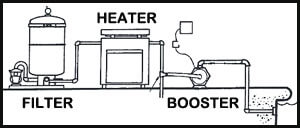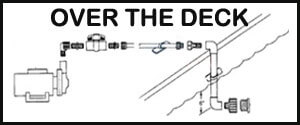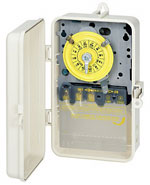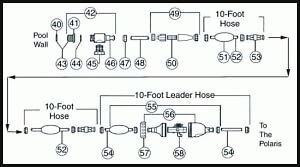 Pool Anti-Freeze: There is one thing that all pools have in common from Intex pools to elaborate custom in-ground pools: After you blow the water out of your pool’s plumbing it is always better to be safe than sorry and protect the lines with Non-Toxic Pool Anti-freeze. Pour it into the skimmer, or use a funnel and hose to drain it into return lines or pool cleaner lines. Do Not use in pumps, filters, heaters or chlorinators – pipes only.
Pool Anti-Freeze: There is one thing that all pools have in common from Intex pools to elaborate custom in-ground pools: After you blow the water out of your pool’s plumbing it is always better to be safe than sorry and protect the lines with Non-Toxic Pool Anti-freeze. Pour it into the skimmer, or use a funnel and hose to drain it into return lines or pool cleaner lines. Do Not use in pumps, filters, heaters or chlorinators – pipes only. Winterizing Plugs: In many sizes, threaded plugs and rubber expansion plugs all serve the same purpose and that is to plug the skimmers, returns and cleaner lines. Winter plugs keep water Out of your pool’s plumbing and to keep the anti-freeze In the pipe. One of the smallest, least costly accessories for closing your pool is also one of the most important. Without pool plugs, your pool cannot be considered really “closed”.
Winterizing Plugs: In many sizes, threaded plugs and rubber expansion plugs all serve the same purpose and that is to plug the skimmers, returns and cleaner lines. Winter plugs keep water Out of your pool’s plumbing and to keep the anti-freeze In the pipe. One of the smallest, least costly accessories for closing your pool is also one of the most important. Without pool plugs, your pool cannot be considered really “closed”.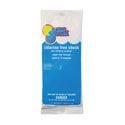 Chlorine-Free Pool Shock: Another versatile universal pool closing go-to is our oxidizing non-chlorine shock. It’s safe for any pool surface, and helps your chlorine by burning-off dead chlorine cells to create more free chlorine in your water. It will not affect your pools pH level or add calcium, binders or cyanuric acid to the water. One of the best reasons to close a pool with non-chlorine shock is that it won’t break down winter algaecide, like chlorine shock will if both are added at the same time.
Chlorine-Free Pool Shock: Another versatile universal pool closing go-to is our oxidizing non-chlorine shock. It’s safe for any pool surface, and helps your chlorine by burning-off dead chlorine cells to create more free chlorine in your water. It will not affect your pools pH level or add calcium, binders or cyanuric acid to the water. One of the best reasons to close a pool with non-chlorine shock is that it won’t break down winter algaecide, like chlorine shock will if both are added at the same time.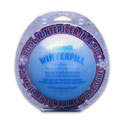 Aqua Pill’s Winter Pill: Unlike the indie rock band band from Massachusetts Winter pills, the Winter Pill is a winter pool chemical that combines enzymes, clarifier, stain fighters, and scale treatment into one set-it-and-forget-it pill. All you have to do is poke a hole in the the pill with the provided pin and drop it in the water. It does the rest of the work and slowly releases the solution throughout the winter. For both above and in-ground pools.
Aqua Pill’s Winter Pill: Unlike the indie rock band band from Massachusetts Winter pills, the Winter Pill is a winter pool chemical that combines enzymes, clarifier, stain fighters, and scale treatment into one set-it-and-forget-it pill. All you have to do is poke a hole in the the pill with the provided pin and drop it in the water. It does the rest of the work and slowly releases the solution throughout the winter. For both above and in-ground pools.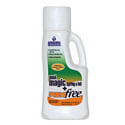 Pool Magic Spring and Fall + Phos-Free: Another popular winter pool treatment combines two of Natural Chemistry’s products, Pool Magic and Phos-Free. Pool Magic has enzymes specially designed to work best in cold water, and with a tremendous appetite for dirt, oil and grime. With the phosphate remover Phos-Free, algae will not have the nutrients it needs to grow in your pool as the water warms-up in Spring. Great for any pool owner, but especially useful for pools with mesh safety covers that allow fine particles and sunlight to sift through.
Pool Magic Spring and Fall + Phos-Free: Another popular winter pool treatment combines two of Natural Chemistry’s products, Pool Magic and Phos-Free. Pool Magic has enzymes specially designed to work best in cold water, and with a tremendous appetite for dirt, oil and grime. With the phosphate remover Phos-Free, algae will not have the nutrients it needs to grow in your pool as the water warms-up in Spring. Great for any pool owner, but especially useful for pools with mesh safety covers that allow fine particles and sunlight to sift through. Ultimate Winterizing Pool Kit: Save money with an In the Swim Winterizing Pool Kit. Dr. Pool’s closing kits are chlorine free, so they’re safe for all pools and all pool surfaces. The Ultimate kit has a bottle of Metal Free and also Pool Magic+Phosfree, 3 lbs of Non-Chlorine Shock, and a slow-release floater with 4 lbs of winter oxidizer (chlorine free). Also available is the less expensive Winter Kit which features the same products as the Ultimate Kit but with Winter Algaecide and Stain Away instead of the Natural Chemistry Products.
Ultimate Winterizing Pool Kit: Save money with an In the Swim Winterizing Pool Kit. Dr. Pool’s closing kits are chlorine free, so they’re safe for all pools and all pool surfaces. The Ultimate kit has a bottle of Metal Free and also Pool Magic+Phosfree, 3 lbs of Non-Chlorine Shock, and a slow-release floater with 4 lbs of winter oxidizer (chlorine free). Also available is the less expensive Winter Kit which features the same products as the Ultimate Kit but with Winter Algaecide and Stain Away instead of the Natural Chemistry Products. Water Tubes: For in-ground pools without a safety cover, the humble water bag, or water tubes. It’s the pool product that everyone hates to buy, but every year you need to buy at least a six-pack of water tubes to replace those that pop holes. Double tubes are best, because they are still usable if one side gets a hole. Instead of water tubes, try Aqua Blocks, 3 ft long plastic water tubs with a snap-on lid. Don’t use bricks, blocks or lumber. Besides looking bad, it could damage your pool cover.
Water Tubes: For in-ground pools without a safety cover, the humble water bag, or water tubes. It’s the pool product that everyone hates to buy, but every year you need to buy at least a six-pack of water tubes to replace those that pop holes. Double tubes are best, because they are still usable if one side gets a hole. Instead of water tubes, try Aqua Blocks, 3 ft long plastic water tubs with a snap-on lid. Don’t use bricks, blocks or lumber. Besides looking bad, it could damage your pool cover. Cover Pumps: Solid winter covers have the added benefit of not allowing sunlight through, which can lead to an algae bloom, and they are not mesh so they prevent dirt, pollen and other unwanted debris from passing through as well. However, they also do not allow rain water or snow melt through either. Automatic cover pumps are activated when a small amount of water collects turning on to pump off the water, through an attached garden hose. Large cover pumps like the Aqua Pro 1/3 hp can also be used for lowering pool water level, draining hot tubs, boats or flooded basements.
Cover Pumps: Solid winter covers have the added benefit of not allowing sunlight through, which can lead to an algae bloom, and they are not mesh so they prevent dirt, pollen and other unwanted debris from passing through as well. However, they also do not allow rain water or snow melt through either. Automatic cover pumps are activated when a small amount of water collects turning on to pump off the water, through an attached garden hose. Large cover pumps like the Aqua Pro 1/3 hp can also be used for lowering pool water level, draining hot tubs, boats or flooded basements.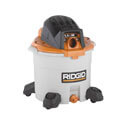 A Wet/Dry Vac: Perhaps a Shop Vac isn't the first thing that pool owners think of when they think of pool supply necessities. No pool can be safely closed with water still in the lines, and no one wants to run the risk of burst or cracked plumbing due to water freezing. A large shop vac (5 HP) can be used to blow out skimmer and return lines. To blow out pool pipes best, and to force water out of main drain lines, use something like the Cyclone Vac to get enough air volume and pressure.
A Wet/Dry Vac: Perhaps a Shop Vac isn't the first thing that pool owners think of when they think of pool supply necessities. No pool can be safely closed with water still in the lines, and no one wants to run the risk of burst or cracked plumbing due to water freezing. A large shop vac (5 HP) can be used to blow out skimmer and return lines. To blow out pool pipes best, and to force water out of main drain lines, use something like the Cyclone Vac to get enough air volume and pressure.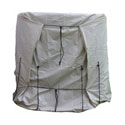 Covers, covers, and covers: For in-ground pools with solar cover reels, the Solar Reel Cover protects your solar blanket from sun and snow. It’s a cover for your cover! And using a Pool Heater Cover protects your heater from moisture, debris and critters. Cover the surface of diving boards to add years to its lifespan. Nobody wants to jump off a cracked and peeling board and a simple Diving Board Cover can keep that from happening.
Covers, covers, and covers: For in-ground pools with solar cover reels, the Solar Reel Cover protects your solar blanket from sun and snow. It’s a cover for your cover! And using a Pool Heater Cover protects your heater from moisture, debris and critters. Cover the surface of diving boards to add years to its lifespan. Nobody wants to jump off a cracked and peeling board and a simple Diving Board Cover can keep that from happening.
Winterizing your pool like a professional is not so hard when you have the right stuff! Sometimes the smallest accessories can make the biggest impact and prevent a spring surprise.

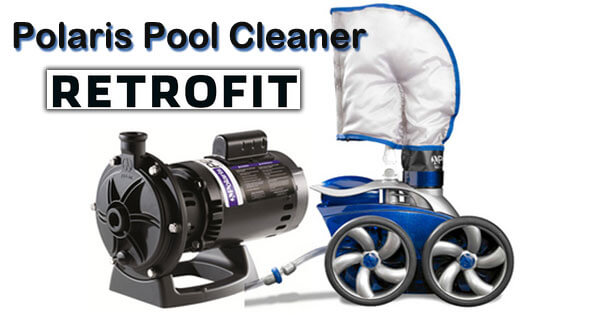
 The nation’s largest pool builders began offering a choice of a vacuum cleaner line, or the newer, pressure cleaner line. Anthony Pools installed thousands of “Antho-Sweep” cleaners, a private labeled Polaris 180.
The nation’s largest pool builders began offering a choice of a vacuum cleaner line, or the newer, pressure cleaner line. Anthony Pools installed thousands of “Antho-Sweep” cleaners, a private labeled Polaris 180. Dig a Trench: After underground utilities are marked, trench from where the booster pump will be located on the equipment pad, to a point midway along the longest wall of the pool. From the edge of the deck to the pool, you can either go under the deck and through the pool wall, or over the deck hose installation.
Dig a Trench: After underground utilities are marked, trench from where the booster pump will be located on the equipment pad, to a point midway along the longest wall of the pool. From the edge of the deck to the pool, you can either go under the deck and through the pool wall, or over the deck hose installation.